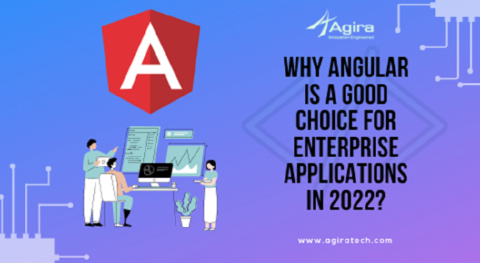Since the invention of smartphones and the rise in popularity of websites, combining the two to create a fantastic user experience has been difficult for the developer community.
Although we can use several methods and frameworks to build the ideal combination of broad reachability and performance, the results were never satisfactory. However, with the introduction of PWAs in 2015, something changed.
PWA (Progressive Web App)
PWA is the product of a unique cross-platform software development approach that uses the mobile browser to deliver web pages installed on your tablet. It’s a cross between a native app and a mobile website that offers an app-like user interface using standard web technologies like CSS, HTML, and JavaScript.
PWAs, unlike native apps, have a faster loading time, can be used offline, and can be found by search engines. They’re why companies like Alibaba, Trivago, and Twitter have a smooth mobile browsing experience.
Advantages of PWAs
- A PWA is compatible with all operating systems and mobile devices since you can access it via a browser (tablets and smartphones).
- A PWA does not require any installation on the user’s smartphone.
- Since a PWA is technically a website, it can benefit from SEO to improve its search rankings.
- Push alerts hold users active in a PWA.
- It has an app-like user interface and user experience that one can also use offline.
- The user does not have to update the PWA manually. All updates carry out automatically.
Disadvantages of PWAs
- Since it uses web technologies that aren’t designed for handheld devices, a PWA depletes the battery faster.
- Despite Apple’s launch of service staff, iOS still does not entirely support any PWA features. The technology is geared for Android users.
- It doesn’t have complete access to hardware features like Face ID and Touch ID, in-app purchases, and camera access, among others.
What’s Trending in PWAs?
According to research, if a PWA can meet all mobile web needs, it can save more than 33% on app creation and maintenance. PWAs have had a positive effect on many brands thanks to features like lightning-fast page loads, light page designs, and simple transitions:
- Mobile sales and profits increased by 20% at Mobify.
- Lancome saw an 8% recovery rate in abandoned shopping carts thanks to pushing alerts sent by their PWA.
- Pinterest redesigned its mobile platform as a Progressive Web App (PWA) and saw a 60 percent rise in interaction.
PWAs’ rising popularity has resulted in many frameworks for companies to choose from while developing PWAs.
1. ReactJS
Because of its extensive JavaScript library, React, released by Facebook in 2013, is a standard option among developers. The Progressive Web App platform can build single-page and multi-page apps with content that loads and changes within a single page. It provides a React PWA solution by using JSX to render functions for connecting HTML structures.
Pros
- PWAs built with React have more flexibility and can be scaled up with additional packages.
- For native applications, developers may use the same code.
- Because of Virtual DOM, the rendering process is fast.
- The Progressive Web App development framework allows for creating API interactions, server-side and static rendered pages, and routing using various JavaScript libraries.
Cons
- Aside from JavaScript, the React PWA solution needs JSX expertise.
- Due to the lack of a conventional approach, implementation is complex.
- Because of the inclusion of JSX, switching from AngularJS is difficult.
- The more versatility you want, the more functionality problems you’ll have with the React PWA solution.
2. AngularJS
AngularJS, which Google created in 2010, is a framework for creating stable and dependable Progressive Web Apps (PWAs) that use the JavaScript ecosystem. PWAs were first to support Angular 5, which was released in 2017. The Progressive Web App development system helps you build a PWA using a JSON setup, so you don’t have to start from scratch.
Angular 8 has two new CLI commands that make it easier to install a web app on a mobile device, unlike previous versions that needed a high level of knowledge to use.
Pros
- The availability of a specified approach makes implementation simple.
- It, like React, has a large developer community.
- Google maintains code, ensuring smooth operations and support.
- The framework’s learning curve is short due to CLI’s contribution.
Cons
- To use the Progressive Web App development platform, you’ll need to know Typescript.
- AngularJS is tangibly more complex than other Progressive Web App frameworks, even though the learning curve has been reduced.
3. VueJS
Vue is a free and open-source JavaScript front-end platform distributed under the MIT license. It’s simple to start with Vue, which the group primarily powers. For instance, features like routing, high-speed rendering, and simple coding will help you speed up the development process.
Pros
- Vue JS, like React, allows for the use of external packages to scale the software.
- The developer group praises it for its simple and accurate documentation.
- Vue allows for quick product delivery, which is ideal for MVPs and smaller solutions.
- It can handle both complex and dynamic applications.
Cons
- Even though the code is fresh and simple to understand, few Vue developers are on the market.
- Since no large corporation owns the Progressive Web App development platform, its support staff is small.
- When using Progressive Web App technologies, the benefit of simplicity causes problems.
4. Ionic
Ionic is an open-source SDK that uses the Angular and Apache Cordova Progressive Web App frameworks to build apps. It was created in 2013 and has since been used to create over five million hybrid applications.
Ionic’s extensive library of components for iOS and Android makes it an excellent choice for PWA development. This can be used to create WebView-enabled web pages that run within the device browser.
Pros
- You don’t need to buy Ionic because it’s open-source. Its software development costs are also modest, making it a good fit for small businesses.
- Anyone familiar with Angular and web technology can use Ionic.
- Debugging software and built-in browser instruments make it simple to maintain.
- Ionic has an extensive library of plugins that allow you to access APIs without having to code.
Cons
- Regular updates necessitate reworking existing PWAs to reflect the changes. Over time, this can become inconvenient.
5. Svelte
Svelte is a modern component-based architecture, similar to Vue. Despite being written in a radically different manner, it is marketed as a “reactive system.” The MIT license is used to sell it. Its most recent version was released in 2019, and The New York Times and GoDaddy were quick to embrace it.
Pros
- Svelte offers quicker page loading, a smaller package size, and leaner syntactic analysis and execution.
- Since it supports plain CSS and various CSS Progressive Web App frameworks, the framework is flexible and basic.
- The PWA kit, which covers critical server staff and boilerplates for meta-data social sharing, is included in the Svelte starter prototype.
Cons
- Since the architecture is so fresh, community support is almost non-existent.
- Since the documentation has not yet been adequately produced, implementation can be complex.
- It doesn’t support TypeScript.
6. Polymer
Polymer is a Google-developed open-source web app platform. It uses HTML, JS, and JSS to create an independent application that includes various templates, PWA resources, and web components.
Polymer’s software and modules are also compatible with a variety of browsers, including Chrome and Opera. This property makes the Polymer extremely adaptable and usable.
Pros
- The APIs are relatively simple to grasp.
- It comes with excellent documentation, which makes the setup process much more manageable.
- Polymer supports the entire web app stack, including responsive layouts, data tiers, and routing.
Cons
- Polymer doesn’t have an IDE for the office.
- Since the architecture isn’t SEO-friendly, it defeats the intent of creating a web app.
- In contrast to PWAs, it has a long page reloading period.
- Because of the embedded development tools in the Progressive Web App development environment, debugging tools are often needed.
Progressive Web Apps’ importance is undeniable in this day and age, so make sure you choose the right one for your company in terms of scale, planned scalability, presence of interactive elements, and complexity.
Talk To Experts
Get end-to-end web application development solutions for an unparalleled back-end and front-end experience. With our top-of-the-line technology expertise, We have been entitled to prestigious titles and awards as the best software development company that caters to industries and clients worldwide.










